Placement and installation of sockets in the kitchen: the best schemes + installation instructions
The most active consumer of electricity in a house or apartment is a kitchen appliance. Therefore, it is important that all sockets in the kitchen are located correctly. This will ensure usability and protect. After all, one incorrectly installed outlet can bring many negative consequences, including causing a fire.
We will familiarize you with all currently applicable power point device options and types of wiring accessories. We have meticulously laid out installation technologies and listed common mistakes that an inexperienced master can make.
We offer the best layouts to interested visitors. Based on the information presented, you can easily cope with the choice of location and device outlet. The text is supplemented by illustrations and video instructions.
The content of the article:
Features of using kitchen outlets
The number of points for connecting to the mains depends on the size of the kitchen and the functions that it will perform. In very small kitchens, it is problematic to place a large number of electrical appliances.
The premises of a larger area make it possible to roam the imagination and desires of the hostess of the house / apartment.
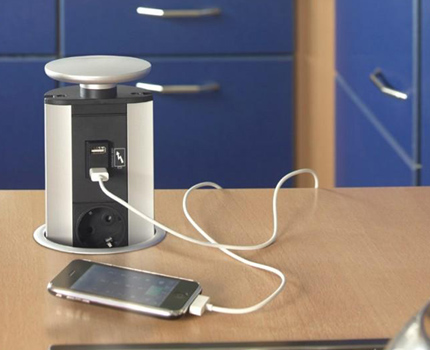
Regardless of the area of the kitchen, the availability of electrical appliances and the number of installed outlets, there are general requirements that they must meet:
- safety of use;
- Free access;
- high-quality installation.
Do not forget that cooking increases the level of humidity, and the use of various powerful equipment gives a high load on the power grid. Therefore, it is important that all outlets installed in the kitchen comply with safety rules.
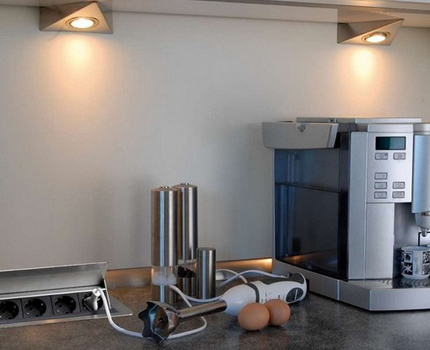
Firstly, you can not put them over the stove and sink. This rule is important to observe when planning and choosing a furniture set.If dramatic design changes have occurred during the repair of the kitchen and the outlet goes directly above the stove, then it must be transferred. Do not endanger your life and hope that everything will somehow work out.
Secondly, if it so happened that electric points were hidden under the sink for connecting kitchen appliances and appliances, then it is advisable to place them above the siphon. The degree of moisture protection of such outlets must be at least IP44.
Thirdly, if small children live in the apartment / house, then this fact must be taken into account. It is better to buy special sockets with curtains and other child protection options. Also, provide such an arrangement so that the electric points are higher than the height of the child.
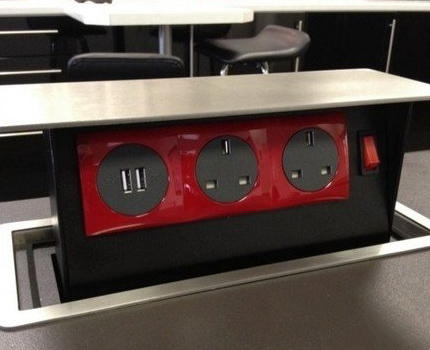
Thirdly, regardless of who installed the sockets - the called specialist or all the work was done on their own, when connecting / disconnecting devices, nothing should hang out, sparkle and smell like burnt plastic.
Fourth, for each powerful electrical appliance should be provided separate line and connection point.
Varieties of kitchen outlets
The functionality of the room and its appearance depend on the correct location of outlets in the kitchen and compliance with installation technologies. Manufacturers offer many different kitchen solutions:
- overhead designer models;
- built-in options mounted inside the wall;
- hidden sockets hidden in drawers, cabinets, closet or countertop;
- angled with or without a fork ejector.
Option overhead sockets less likely to choose for the kitchen. After all, when the entire mechanism is protected from external influences only by the box of the outlet itself, this raises concerns about the safety of its use.
Recessed ground models more often used to connect powerful kitchen appliances, placing them so that there is free access. Manufacturers offer many different models that can harmoniously fit into the style of any design interior.
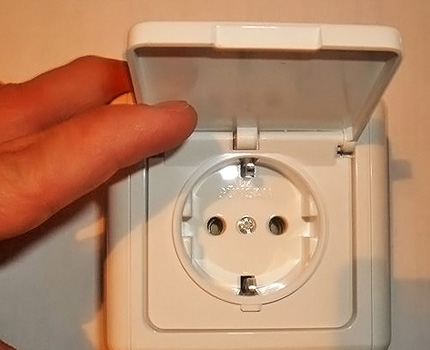
Countertop Mounted hidden sockets they cut into kitchen furniture, hide them in drawers, leaving the cabinet, and use as additional points for connecting rarely used appliances.
They are a stylish complement to almost any interior solution, allowing you to save useful space.
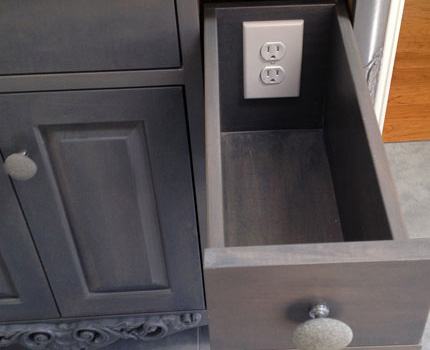
Fashionable and functional trend in the world of sockets - corner models. They come with and without a fork ejector. This option allows you to use the free space of the corners between two walls or between a wall and a countertop.
Manufacturers offer strong and attractive solutions that harmoniously complement the interior of the kitchen.

The best accommodation options
The question of installing electrical outlets in the kitchen arises on the threshold of repair. It is necessary to approach his decision carefully, in order to avoid trouble in the future. First, you need to plan what kind of appliances will be installed in the kitchen. You also need to consider the electrical appliances to be used.
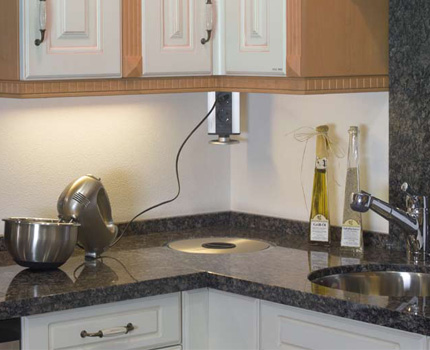
Then it is important to determine the model of the kitchen set, comparing its actual dimensions with the repaired room.When choosing furniture, one must take into account all the desires and needs, so that after a month, when all the rough work has already been done, suddenly not change your mind.
If, nevertheless, a decision has been made to radically change the design and order other furniture, then it is imperative to revise the previous scheme for placing electrical outlets in the kitchen. In the case when the installed sockets do not fit into the new version of the arrangement of kitchen furniture, it is better to transfer them, for security purposes.
When planning the installation of electrical points for connecting kitchen appliances, it is advisable to use the rule of vertical zoning.
So, for consumers of electricity, located on top - the hood, the lighting of kitchen cabinets, a TV, additional light sources - should provide top-level sockets. They are located at a height of 5 to 10 cm from the top edge of the wall cabinet.
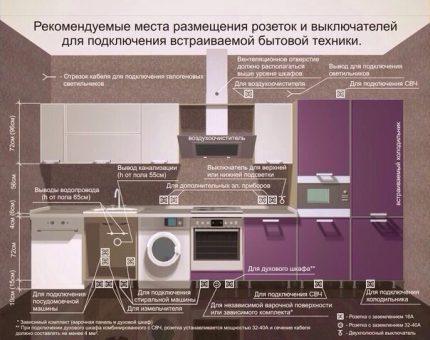
The average level is electric points for connecting low-power kitchen appliances. They are conveniently located above the countertop to provide the most simple and quick access. The preferred distance is from 10 to 30 cm from the level of the countertop. For security reasons, sockets of this level must be removed from the stove and sink to a distance of about 60 cm.
For built-in kitchen appliances, low-level sockets should be provided. They are located at a distance of 30 to 60 cm from the floor. Most often, they are placed in adjacent cabinets and cabinets, having cut out the corresponding holes in the rear wall for this.
The option of mounting the outlet behind the stove or dishwasher itself is considered unacceptable due to the lack of free access to it.
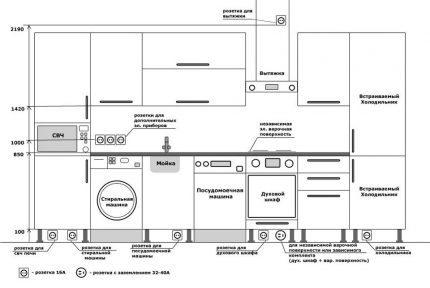
When completing planning, you need to add a couple more spare ones to the total number of required connection points. Also, do not forget about the need to periodically turn on the inhaler, gadget chargers, laptop and other portable equipment. For such devices, it is convenient to use extendable models and sockets that are built into the countertop.
Read about how to transfer an electric point to another place. article on our website.
Detailed installation instructions
The most important thing in installing outlets is to approve the number and location. This issue should be resolved first. Having decided on a plan for placing electrical outlets in your kitchen, you can proceed to the following work.
First you have to do the markup, indicating where exactly and how many outlets you need to install. Next lay power cable to the kitchen. Here you need to consider the number of powerful energy consumers.
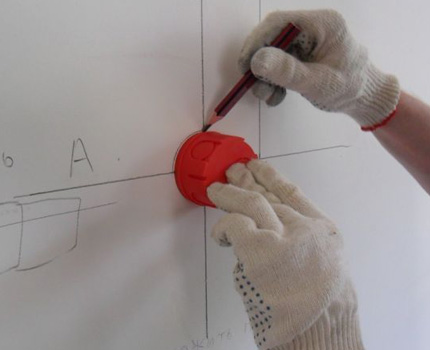
For example, a boiler, an electric stove or an oven need to lay separate wires for connection. Their high power involves the use of a reliable and high-quality copper cable with a cross section of 6 mm2 for a single-phase voltage circuit and a cross section of 4 mm2 for three phase.

When laying the cable for installation of an electric socket necessarily installed circuit breakers at 40 A or fuses at 32 A. For less powerful consumers of electricity take a copper conductor with a cross section of 2.5 mm2 and, depending on the total load on the line, they put protective devices on 16 A or 25 A.

Choosing between cheaper aluminum wiring and more reliable, but expensive, copper, it is better to overpay for reliability. Copper conductors are able to withstand heavy loads, which is especially true for the kitchen. Also, when laying the power cable, do not forget about reliable insulation.
It is important to consider the material of the walls:
- a recess is cut in the concrete and brick walls, a power cable is placed in it, packed in a corrugated pipe made of high-quality plastic;
- for wooden walls, this option will not only be unacceptable, but also extremely dangerous;
- if the walls are sheathed with drywall, then nothing will have to be cut - the wiring is remarkably laid in the voids of the walls;
- Another option is to use a decorative plastic baseboard with cable channels for wiring.
If the latter options are the simplest, then for laying hidden wiring in a concrete wall, you have to work hard - do special channels for the wires. No punch or grinder is indispensable here. You will also need a special nozzle on the hammer drill to form holes for sockets.
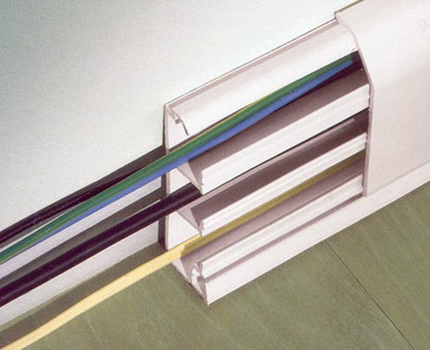
Having completed the gating of the walls, it is necessary to place the supply cable in the recesses obtained, leading it to the places of the planned location of the outlets in the kitchen. Then you have to clean the channel with the wiring from dust. Now carefully seal with a solution of gypsum or alabaster.
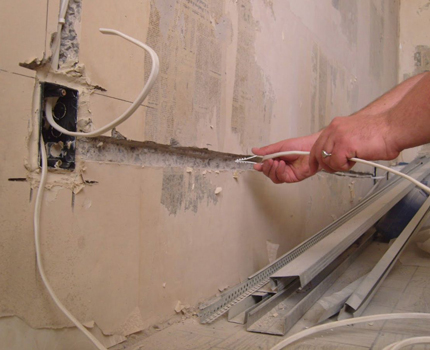
The holes for the sockets are filled with mortar according to the same principle. First, everything is cleaned of debris, pebbles and dust, and a power cable is threaded into the glass itself. For reliable fixation, all the cracks between the socket and the wall are completely filled with a solution of alabaster or gypsum. It remains to wait for complete drying.
These works, if desired and the availability of appropriate tools, can be done on their own. Most often, specialists with considerable experience and skill are invited to lay wiring, leaving for themselves the work of connecting outlets.
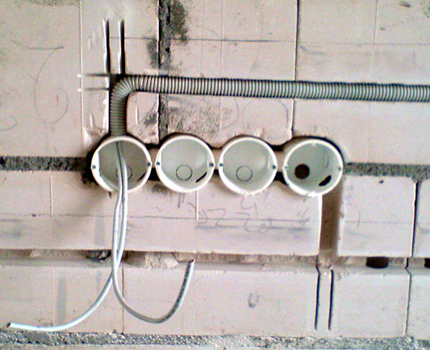
When the conclusions for the installation of kitchen outlets are ready, you can proceed with the installation. To do this, you need to take the tools, and the purchased sockets will first have to be disassembled by removing the front decorative trim and separating the mechanism.
Using an indicator screwdriver, you should definitely check if there is voltage in the network - it should not be there! Before installing the outlet, it is important to make sure that all wires with which to work are de-energized.
After making sure that there is no current, you can start connecting the socket mechanism and the wires of the power cable. To do this, remove the protective braid from the cable, stripper stripper the edges of each of the 3 wires at a distance of 1 cm from the edge, saving them insulation.
The bare wires are alternately connected to the outlet mechanism. Each of the wires plays a role;
- yellow-green is grounding. It connects to the center pin;
- blue (may be blue and white) is a working zero. It is to be connected to the extreme contact of the socket mechanism;
- the third wire can be of any motley color - beige-brown, red, black or just white. This is a phase wire that connects to the second end contact.
The type of connection depends on the outlet used.It can be spring when the connection is made by pressing a special key, or screw, if the wires are fixed with screw clamps between the plates.
After attaching all the wires, you need to attach the socket mechanism tightly to the socket with screws. Then you should check with a level whether everything is exactly centered. If everything is in order, you can screw on the front of the outlet and check the quality of their work with a light bulb or other serviceable device. Previously, do not forget to turn on the current on this line.
The following selection will familiarize you with the features of connecting electrical fittings with screw clamps:
If the light comes on, the installation of the kitchen outlet has been completed successfully. Otherwise, you have to disassemble everything and reconnect, not forgetting to disconnect the line before starting work.
Mortise models of sockets can also be installed on their own. To do this, carefully cut out the holes in the countertop or cabinet using special tools. In the accompanying instructions, the manufacturer indicates in detail how to properly connect and use his product.
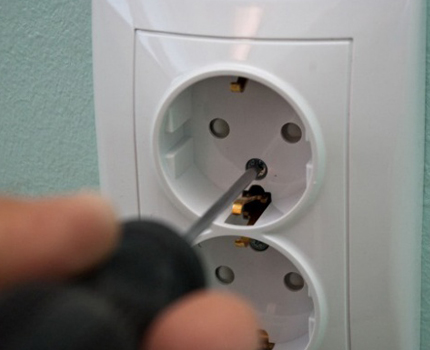
You can also use the services of specialists to perform all installation work - it depends on the desire, skills and available tools from the owner of the house / apartment.
Often, for powerful consumers of foreign production, a socket with a Euro connector is required.Below is a sequence of work on its installation:
The main mistakes in the placement of outlets
The importance of the correct location and connection of kitchen outlets is difficult to overestimate. Any, even the most original kitchen, is first of all obliged to be safe. It is not uncommon for owners to underestimate this requirement. This happens mainly due to inexperience, because they do not do a full repair of the room every month.
Among the mistakes made when placing kitchen outlets, there are both frankly rude and insignificant. If minor flaws bring during operation only inconvenience and a certain discomfort, then serious flaws can cause many troubles.
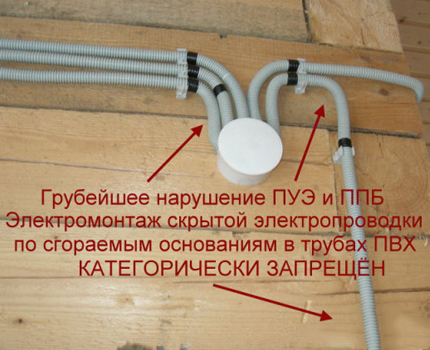
The worst thing is neglect of safety rules. This is when the wiring is laid incorrectly, the material of the walls and the desired insulation option in a particular case are not taken into account. Such negligence is fraught with dire consequences - with a short circuit from the whole house in a matter of minutes, only ashes will remain.
The second serious violation is when all wiring accessories are powered from one power cable. This layout of the outlets in the kitchen does not hold water, because the line is simply not able to withstand the voltage.
As a result, a completely non-functional room. You should always ensure that only one powerful or 2-3 low-power device is turned on. This is unacceptable for the kitchen.
The third mistake is if a separate line, coming from the shield, has not been allocated for the electric stove. This powerful consumer of electric current will work efficiently only if it is connected correctly.
Fourth, all sockets hidden under the sink must have an appropriate degree of protection against moisture - at least IP44. Groups of electric points located in the free access zone of children must be selected with protective curtains.
Fifthly, for all devices working with water, for example, a dishwasher or washing machine, it is important to make a separate supply line.It must be equipped with a residual current device, and it is advisable to take installed sockets with grounding. In the event of a short circuit, these measures will help protect the home from harm by disconnecting the line.
Some minor errors in the placement of kitchen outlets include the inconvenient location of some of their groups. It’s also bad when they forgot to provide for a couple of spare points, for example, for a phone or laptop charger.
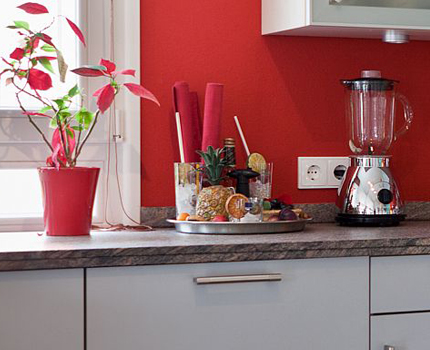
Another unpleasant drawback is when the color and shape of the housing of the installed outlets is knocked out of the general design of the room. This usually happens if the owners change the general concept of the kitchen many times. Having bought the necessary materials, they suddenly decide to change the color scheme or order other furniture, forgetting about the already mounted outlets.
Conclusions and useful video on the topic
Video # 1. What is the best way to arrange kitchen outlets, as well as, emphasis on the main mistakes in their placement:
Video # 2. Features of electrical wiring in the kitchen and places of sockets:
Video # 3. Visual video about connecting the built-in outlet block:
Video # 4. Overview of a retractable outlet plugged into a countertop:
Given the basic recommendations for the placement of kitchen outlets, you can design the most convenient workspace, rest area and meal. A cozy kitchen where it is comfortable not only to cook, but also to gather for a family dinner, can become one of the most favorite places in the house. It's great when the right things have taken their place and are always at hand.
We are waiting for your stories about personal experience in choosing a place and installing outlets in the kitchen. Please comment in the block located under the text of the article. Here you can ask questions and point out flaws if they were discovered during the familiarization with the material.

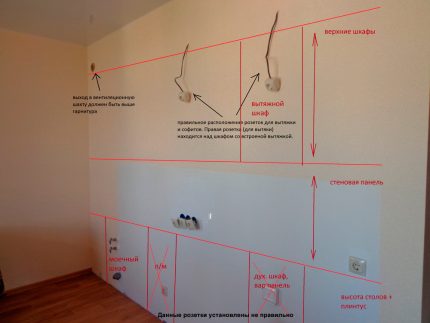
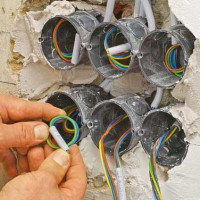 How to connect an outlet block: installation rules and connection diagrams
How to connect an outlet block: installation rules and connection diagrams 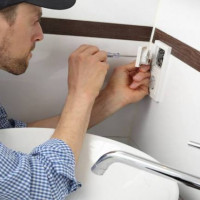 Installation of sockets in the bathroom: safety standards + installation instruction
Installation of sockets in the bathroom: safety standards + installation instruction 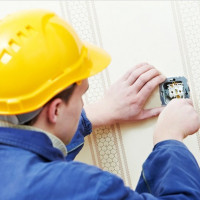 Connecting a double switch: standards and diagrams + installation instruction
Connecting a double switch: standards and diagrams + installation instruction 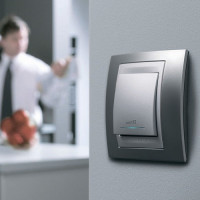 Installation height of sockets and switches: where and how to position?
Installation height of sockets and switches: where and how to position? 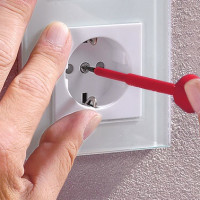 Serial and parallel connection of sockets: a loop and a star
Serial and parallel connection of sockets: a loop and a star 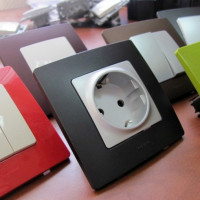 Types of electrical outlets and switches: what are and how to choose wisely
Types of electrical outlets and switches: what are and how to choose wisely  How much does it cost to connect gas to a private house: the price of organizing gas supply
How much does it cost to connect gas to a private house: the price of organizing gas supply  The best washing machines with dryer: model rating and customer tips
The best washing machines with dryer: model rating and customer tips  What is the color temperature of light and the nuances of choosing the temperature of the lamps to suit your needs
What is the color temperature of light and the nuances of choosing the temperature of the lamps to suit your needs  Replacement of a geyser in an apartment: replacement paperwork + basic norms and requirements
Replacement of a geyser in an apartment: replacement paperwork + basic norms and requirements
I initially made a mistake when I put outlets without curtains. When the son began to move around the apartment, he had to urgently buy plugs for sockets. And with the electric stove, it didn’t work out very well either - they did a permutation and had to add a cable for it. Now we are again in the repair process. Now I consider all these nuances for safety.
Outlets in the kitchen are a serious headache. There are a lot of different equipment and devices, but there are few sockets, you won’t hang the whole wall with sockets. And when you move to a new apartment, so generally horror! When my wife and I bought an apartment in the secondary house and arranged furniture with appliances in the kitchen not like the previous owners did, but in our own way, we were horrified to find that both outlets needed to be moved. I had to do unplanned repairs in the kitchen because of this.
Who taught you to place sockets under the sinks ??? Who???!!!! It is FORBIDDEN, as well as above the sink, and at least 50 cm should be retreated from gas pipes.
You are right, placing the outlet under and above the sink is expressly prohibited in clause 14.29 of SP 31-110 2003. Unfortunately, I often see now that people neglect safety because of the desire to fit all the appliances in the kitchen.
Hello. You are right that this may be unsafe, however, you did not correctly interpret the point of the joint venture.
“14.29. The distance from sockets intended for connecting stationary kitchen electric stoves and air conditioners to the housings of these appliances is not standardized. At the same time, it is not allowed to place sockets under and above the sinks. The distance from the body of the stationary kitchen electric stove to the grounded parts of the sanitary equipment, steel heating pipes, hot and cold water supply, sinks and radiators is not standardized“.
“... stationary kitchen electric stoves and air conditioners” - not a word about refrigerators, lamps and other appliances.